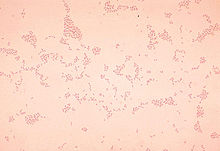Actinobacillus
| Actinobacillus | |
|---|---|

| |
| Actinobacillus suis | |
| Scientific classification | |
| Domain: | Bacteria |
| Phylum: | Pseudomonadota |
| Class: | Gammaproteobacteria |
| Order: | Pasteurellales |
| Family: | Pasteurellaceae |
| Genus: | Actinobacillus Brumpt 1910 |
| Species | |
|
A. actinomycetemcomitans | |
Actinobacillus is a genus of Gram-negative, nonmotile and non-spore-forming, oval to rod-shaped bacteria occurring as parasites or pathogens in mammals, birds, and reptiles.[1] It is a member of the family Pasteurellaceae.[2] The bacteria are facultatively anaerobic or aerobic, capable of fermenting carbohydrates (without production of gas), and of reducing nitrates. The genomic DNA contains between 40 and 47 mol % guanine plus cytosine.
Actinobacillus (Pasteurella) ureae and A. hominis occur in the respiratory tracts of healthy humans and may be involved in the pathogenesis of sinusitis, bronchopneumonia, and meningitis. A. actinomycetemcomitans occurs in the human oral microflora,[3] and together with anaerobic or capnophilic organisms (HACEK group organisms) may cause endocarditis. Actinobacilli are susceptible to most antibiotics of the beta-lactam family, aminoglycosides, tetracyclines, chloramphenicol, and many other antibacterial chemotherapeutics.
An analysis of A. actinomycetemcomitans indicated it was monophyletic with Haemophilus aphrophilus and H. segnis, and they were proposed to be reclassified as a new genus, Aggregatibacter (from the Latin aggregare, meaning "to come together").[4][5]
References[edit]
- ^ Chung; et al. (2008). "Actinobacillus pleuropneumoniae". Pasteurellaceae: Biology, Genomics and Molecular Aspects. Caister Academic Press. ISBN 978-1-904455-34-9.
- ^ Kuhnert P; Christensen H, eds. (2008). Pasteurellaceae: Biology, Genomics and Molecular Aspects. Caister Academic Press. ISBN 978-1-904455-34-9.
- ^ Rogers A H, ed. (2008). Molecular Oral Microbiology. Caister Academic Press. ISBN 978-1-904455-24-0.
- ^ Nørskov-Lauritsen N, Kilian M (September 2006). "Reclassification of Actinobacillus actinomycetemcomitans, Haemophilus aphrophilus, Haemophilus paraphrophilus and Haemophilus segnis as Aggregatibacter actinomycetemcomitans gen. nov., comb. nov., Aggregatibacter aphrophilus comb. nov. and Aggregatibacter segnis comb. nov., and emended description of Aggregatibacter aphrophilus to include V factor-dependent and V factor-independent isolates". Int. J. Syst. Evol. Microbiol. 56 (Pt 9): 2135–46. doi:10.1099/ijs.0.64207-0. PMID 16957111.
- ^ Nørskov-Lauritsen, N (Apr 2014). "Classification, identification, and clinical significance of haemophilus and aggregatibacter species with host specificity for humans". Clinical Microbiology Reviews. 27 (2): 214–40. doi:10.1128/CMR.00103-13. PMC 3993099. PMID 24696434.
